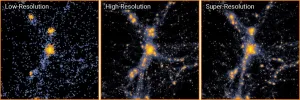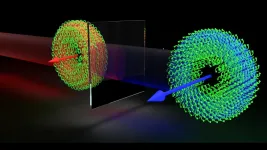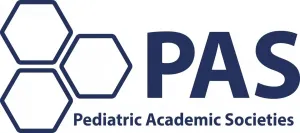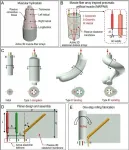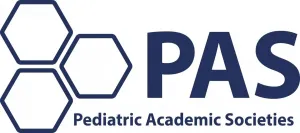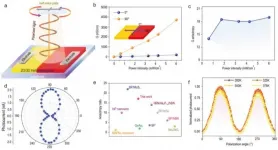(Press-News.org) A universe evolves over billions upon billions of years, but researchers have developed a way to create a complex simulated universe in less than a day. The technique, published in this week's Proceedings of the National Academy of Sciences, brings together machine learning, high-performance computing and astrophysics and will help to usher in a new era of high-resolution cosmology simulations.
Cosmological simulations are an essential part of teasing out the many mysteries of the universe, including those of dark matter and dark energy. But until now, researchers faced the common conundrum of not being able to have it all ¬-- simulations could focus on a small area at high resolution, or they could encompass a large volume of the universe at low resolution.
Carnegie Mellon University Physics Professors Tiziana Di Matteo and Rupert Croft, Flatiron Institute Research Fellow Yin Li, Carnegie Mellon Ph.D. candidate Yueying Ni, University of California Riverside Professor of Physics and Astronomy Simeon Bird and University of California Berkeley's Yu Feng surmounted this problem by teaching a machine learning algorithm based on neural networks to upgrade a simulation from low resolution to super resolution.
"Cosmological simulations need to cover a large volume for cosmological studies, while also requiring high resolution to resolve the small-scale galaxy formation physics, which would incur daunting computational challenges. Our technique can be used as a powerful and promising tool to match those two requirements simultaneously by modeling the small-scale galaxy formation physics in large cosmological volumes," said Ni, who performed the training of the model, built the pipeline for testing and validation, analyzed the data and made the visualization from the data.
The trained code can take full-scale, low-resolution models and generate super-resolution simulations that contain up to 512 times as many particles. For a region in the universe roughly 500 million light-years across containing 134 million particles, existing methods would require 560 hours to churn out a high-resolution simulation using a single processing core. With the new approach, the researchers need only 36 minutes.
The results were even more dramatic when more particles were added to the simulation. For a universe 1,000 times as large with 134 billion particles, the researchers' new method took 16 hours on a single graphics processing unit. Using current methods, a simulation of this size and resolution would take a dedicated supercomputer months to complete.
Reducing the time it takes to run cosmological simulations "holds the potential of providing major advances in numerical cosmology and astrophysics," said Di Matteo. "Cosmological simulations follow the history and fate of the universe, all the way to the formation of all galaxies and their black holes."
Scientists use cosmological simulations to predict how the universe would look in various scenarios, such as if the dark energy pulling the universe apart varied over time. Telescope observations then confirm whether the simulations' predictions match reality.
"With our previous simulations, we showed that we could simulate the universe to discover new and interesting physics, but only at small or low-res scales," said Croft. "By incorporating machine learning, the technology is able to catch up with our ideas."
Di Matteo, Croft and Ni are part of Carnegie Mellon's National Science Foundation (NSF) Planning Institute for Artificial Intelligence in Physics, which supported this work, and members of Carnegie Mellon's McWilliams Center for Cosmology.
"The universe is the biggest data sets there is -- artificial intelligence is the key to understanding the universe and revealing new physics," said Scott Dodelson, professor and head of the department of physics at Carnegie Mellon University and director of the NSF Planning Institute. "This research illustrates how the NSF Planning Institute for Artificial Intelligence will advance physics through artificial intelligence, machine learning, statistics and data science."
"It's clear that AI is having a big effect on many areas of science, including physics and astronomy," said James Shank, a program director in NSF's Division of Physics. "Our AI planning Institute program is working to push AI to accelerate discovery. This new result is a good example of how AI is transforming cosmology."
To create their new method, Ni and Li harnessed these fields to create a code that uses neural networks to predict how gravity moves dark matter around over time. The networks take training data, run calculations and compare the results to the expected outcome. With further training, the networks adapt and become more accurate.
The specific approach used by the researchers, called a generative adversarial network, pits two neural networks against each other. One network takes low-resolution simulations of the universe and uses them to generate high-resolution models. The other network tries to tell those simulations apart from ones made by conventional methods. Over time, both neural networks get better and better until, ultimately, the simulation generator wins out and creates fast simulations that look just like the slow conventional ones.
"We couldn't get it to work for two years," Li said, "and suddenly it started working. We got beautiful results that matched what we expected. We even did some blind tests ourselves, and most of us couldn't tell which one was 'real' and which one was 'fake.'"
Despite only being trained using small areas of space, the neural networks accurately replicated the large-scale structures that only appear in enormous simulations.
The simulations didn't capture everything, though. Because they focused on dark matter and gravity, smaller-scale phenomena -- such as star formation, supernovae and the effects of black holes -- were left out. The researchers plan to extend their methods to include the forces responsible for such phenomena, and to run their neural networks 'on the fly' alongside conventional simulations to improve accuracy.
INFORMATION:
The research was powered by the Frontera supercomputer at the Texas Advanced Computing Center (TACC), the fastest academic supercomputer in the world. The team is one of the largest users of this massive computing resource, which is funded by the NSF Office of Advanced Cyberinfrastructure.
This research was funded by the NSF, the NSF AI Institute: Physics of the Future and NASA.
As pandemic lockdowns went into effect in March 2020 and millions of Americans began working from home rather than commuting to offices, heavy traffic in America's most congested urban centers--like Boston--suddenly ceased to exist. Soon afterwards, the air was noticeably cleaner. But that wasn't the only effect. A team of Boston University biologists who study how human-related sounds impact natural environments seized the opportunity to learn how the reduced movement of people would impact local ecosystems. They found--surprisingly--that sound levels increased in some nature conservation areas, a result of cars driving faster on roads no longer choked by traffic.
BU ecologist Richard Primack and Carina Terry, an undergraduate student working in Primack's ...
Spinning or rotating objects are commonplace, from toy tops, fidget spinners, and figure skaters to water circling a drain, tornadoes, and hurricanes.
In physics, there are two kinds of rotational motion: spin and orbital. Earth's motion in our solar system illustrates these; the daily 360-degree rotation of Earth around its own axis is spin rotation, while Earth's yearly trip around the sun is orbital rotation.
The quantity in physics defined to describe such motion is angular momentum (AM). AM is a conserved quantity: given an initial amount of it, it can be broken up and redistributed among particles such as atoms and photons, ...
BOSTON -- Immunity often calls to mind the adaptive immune response, made up of antibodies and T cells that learn to fight specific pathogens after infection or vaccination. But the immune system also has an innate immune response, which uses a set number of techniques to provide a swift, non-specialized response against pathogens or support the adaptive immune response.
In the past few years, however, scientists have found that certain parts of the innate immune response can, in some instances, also be trained in response to infectious pathogens, such as HIV. Xu Yu, MD, a Core Member of the Ragon Institute of MGH, MIT and Harvard, and colleagues ...
Adults are more compassionate and are up to twice as likely to donate to charity when children are present, according to a new study from psychologists.
The research, conducted by social psychologists at the University of Bath and Cardiff University and funded by the Economic and Social Research Council (ESRC), examined how the presence of children influences adults' compassionate motivations and behaviours.
Across eight experiments and more than 2,000 participants, the researchers asked adults to describe what typical children are like. After focusing on children in this way, participants ...
A hot topic symposia session during the Pediatric Academic Societies (PAS) 2021 Virtual Meeting will discuss a multipronged approach to addressing childhood adversity and promoting resilience - at the clinical, systems, community and educational levels.
The effect of adverse childhood experiences (ACEs) on health outcomes across the lifespan is well recognized among pediatric practitioners. Increasing the ability of healthcare providers to recognize and respond to ACEs can buffer the long-term negative physical and mental health impacts of adversity and increase patient-centered care.
"In the era of COVID-19, ...
Biological organisms (such as elephant trunks, octopus tentacles, and human tongues) show remarkable dexterity and self-adaptation in unstructured environments, relying on the multiple-mode actuations of the skeleton-free muscular hydrostats. In general, muscular hydrostats mainly consist of well-ranged active 3D muscle-fiber arrays bundled by passive connective tissues (Fig. 1A). By selectively actuating the active 3D muscle-fiber arrays, muscular hydrostats can generate elongation, bending, contraction and twisting. Producing such multiple-mode actuation of muscular hydrostats is an interesting but long-lasting challenge in the field of robotics.
During past decades, many artificial muscles (such ...
A Pediatric Policy Council state of the art plenary session during the Pediatric Academic Societies (PAS) 2021 Virtual Meeting explored the role of public health research in iterative policymaking to reduce gun violence in America.
The toll of gun violence on young people represents one of the most significant public health challenges facing contemporary America. In recent years, firearm-related injury and death has made headlines routinely, including mass shootings at schools, public festivals, and places of worship, while daily occurrences of gun violence affect local communities.
Gun ...
Originally formulated in the context of condensed matter physics, the Haldane model is an influential model of a two-dimensional topological insulator. It has also been realized in classical-wave metamaterial analogues of topological insulator, such as photonic crystals, acoustic crystals, and electric LC circuits.
Recently, theorists have shown that a modification to the Haldane model exhibits the novel phenomenon of antichiral edge sates, according to E. Colomés and M. Franz, scholars at Department of Physics and Astronomy and Quantum Matter Institute, University of British Columbia. Unlike the chiral edge states associated with the standard Haldane model, antichiral edge states possess the same propagation direction on opposite edges of a sample; the current carried by the edge ...
Researchers at University of California San Diego School of Medicine, with colleagues elsewhere, have used gene therapy to prevent learning and memory loss in a mouse model of Alzheimer's disease (AD), a key step toward eventually testing the approach in humans with the neurodegenerative disease.
The findings are published online in advance of the June 11, 2021 issue of Molecular Therapy-Methods & Clinical Development.
AD is characterized by the accumulation of clumps of misfolded proteins called amyloid plaques and neurofibrillary tau tangles, both of which impair cell signaling and promote neuronal death. Current AD treatments targeting plaques and tangles address ...
Polarization-sensitive photodetectors, based on anisotropic semiconductors, have exhibited wide advantages in specialized applications, such as astronomy, remote sensing, and polarization-division multiplexing. For the active layer of polarization-sensitive photodetectors, recent researches focus on two-dimensional (2D) organic-inorganic hybrid perovskites, where inorganic slabs and organic spacers are alternatively arranged in parallel layered structures. Compared with inorganic 2D materials, importantly, the solution accessibility of hybrid perovskites makes it possible to obtain their large crystals at low cost, offering exciting opportunities to incorporate crystal out-of-plane anisotropy for polarization-sensitive photodetection. However, limited by ...
